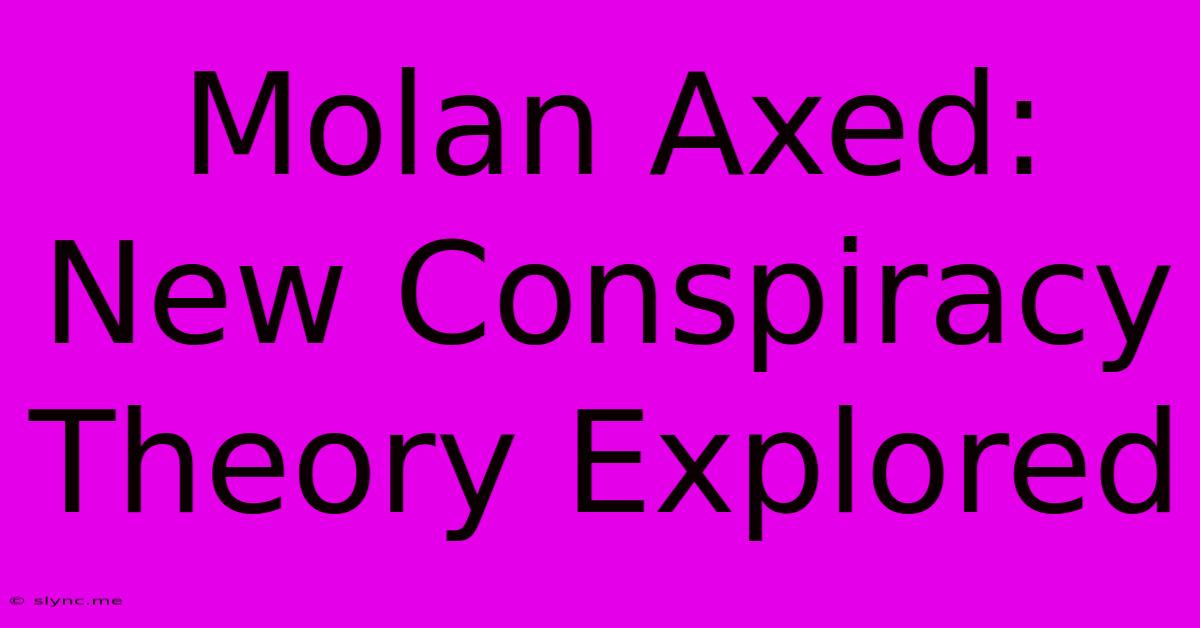Molan Axed: New Conspiracy Theory Explored

Discover more detailed and exciting information on our website. Click the link below to start your adventure: Visit Best Website Mrs.Amykhan. Don't miss out!
Table of Contents
Molan Axed: New Conspiracy Theory Explored
The internet is a breeding ground for conspiracy theories, and a new one has emerged, captivating the attention of many: the "Molan Axed" theory. While lacking concrete evidence, its spread highlights the power of online narratives and the human tendency to seek explanations, even in the absence of facts. This article delves into the core of the "Molan Axed" conspiracy, exploring its origins, key claims, and the reasons behind its viral spread.
What is the "Molan Axed" Conspiracy Theory?
The exact details of the "Molan Axed" theory vary depending on the source, but the central theme revolves around the supposed deliberate sabotage or silencing of a prominent individual or entity, referred to as "Molan." The nature of this "Molan" remains ambiguous, with interpretations ranging from a specific person to a broader concept or organization. The "axing," or elimination, is alleged to have been carried out by a powerful, shadowy group, often unspecified, to suppress information or maintain control.
Crucially, there's no verifiable evidence to support the theory. The claims often rely on circumstantial evidence, misinterpreted information, or outright speculation. This lack of concrete proof is a hallmark of many conspiracy theories, fueling speculation and leading to a spread of misinformation.
Key Claims and Arguments:
While the specifics are fluid, common claims within the "Molan Axed" theory typically include:
- Suppression of Truth: The central claim is that "Molan" possessed crucial information that threatened powerful interests, leading to their removal from the public eye.
- Coordinated Effort: Proponents often suggest a coordinated campaign involving multiple actors to silence "Molan" and bury the incriminating information.
- Lack of Transparency: The absence of official explanations or investigations is often cited as further evidence of a cover-up.
Why the Theory Went Viral:
The rapid spread of the "Molan Axed" theory can be attributed to several factors:
- Ambiguity and Mystery: The vague nature of "Molan" and the lack of clear details allow for multiple interpretations, making it engaging for those drawn to unsolved mysteries.
- Confirmation Bias: Individuals who already hold distrustful views towards powerful institutions may be more likely to accept the theory, aligning with their pre-existing beliefs.
- Social Media Algorithms: Online platforms, through their algorithms, often amplify sensational content, regardless of its truthfulness, leading to widespread dissemination.
- Sense of Community: The theory fosters a sense of community among those who believe it, strengthening its grip through shared belief and online discussions.
Analyzing the Conspiracy: A Critical Perspective
It's vital to approach the "Molan Axed" conspiracy theory, and all such theories, with a critical and skeptical lens. The absence of concrete evidence and the reliance on speculation and conjecture should raise significant red flags. It's essential to:
- Verify Information: Always cross-reference information from multiple reliable sources before accepting it as fact.
- Identify Bias: Be aware of your own biases and how they might influence your interpretation of information.
- Consider Alternative Explanations: Explore alternative explanations that don't rely on conspiracy theories.
Conclusion:
The "Molan Axed" conspiracy theory, while lacking verifiable evidence, offers a compelling case study in the dynamics of online misinformation. Understanding how such theories emerge, spread, and capture attention is crucial in navigating the complex landscape of online information. By employing critical thinking and relying on reliable sources, we can better discern truth from fiction in the digital age. The spread of the "Molan Axed" theory serves as a reminder of the importance of media literacy and the need for critical evaluation of information found online.

Thank you for visiting our website wich cover about Molan Axed: New Conspiracy Theory Explored. We hope the information provided has been useful to you. Feel free to contact us if you have any questions or need further assistance. See you next time and dont miss to bookmark.
Also read the following articles
| Article Title | Date |
|---|---|
| Lviv Grafik Vidklyuchen Elektroenergiyi | Dec 13, 2024 |
| Qantas Reports High On Time Arrivals | Dec 13, 2024 |
| Liga Konferentsiy Rezultati 5 Turu | Dec 13, 2024 |
| 13 Grudnya 2024 Kalendar Svyatkovikh Dat | Dec 13, 2024 |
| Many Qantas Flights Arrive On Time | Dec 13, 2024 |
